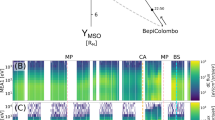Abstract
The dynamic equilibrium of the ozone layer can be locally disturbed when considerable volumes of methane penetrate into the stratosphere as a result of powerful emissions of methane from the lithosphere. Calculations indicate that, in order to break through the tropopause, the methane emission is bound to be greater than 109 m3; such emissions are related to unique poorly studied phenomena. The performed studies of the methane emergence height (which can increase owing to hydrogen adding, joint emergence of a periodic system of methane bubbles located in the same plane near the Earth’s surface, or emergence of two coaxial bubbles released at different times) have demonstrated that the methane maximum emergence height does not change radically.
Similar content being viewed by others
References
G. Etiope, “New Directions: GEM—Geologic Emission of Methane, the Missing Source in the Atmospheric Methane Budget,” Atmos. Environ., No. 38, 3099–3100 (2004).
G. Brasseur and S. Solomon, Aeronomy of the Middle Atmosphere (Reidel, Dordrecht, 1984; Gidrometeoizdat, Leningrad, 1987).
V. V. Adushkin, V. P. Kudryavtsev, and S. B. Turuntaev, “Global Methane Flux in Intergeospheric Gas Exchange,” Dokl. Akad. Nauk 391, 813–816 (2003).
A. V. Milkov, R. Sassen, and T. V. Apanasovich, “Global Gas Flux from Mud Volcanoes: A Significant Source of Fossil Methane in the Atmosphere and the Ocean,” Geophys. Res. Lett. 3(2), 9-1–9-4 (2003).
A. J. Kopf, “Significance of Mud Volcanism,” Rev. Geophys. 40(2), 2-1–2-52 (2002).
E. Suess et al., “Gas Hydrate Destabilization: Enhanced Dewatering, Benthic Material Turnover and Large Methane Plumes at the Cascadia Convergent Margin,” Earth Planet. Sci. Lett. 170(1–2), 1–15 (1999).
Yu. F. Makogon, “Russia’s Contribution to the Study of Gas Hydrates,” in Natural Gas Hydrates, Ed. by E. D. Sloan Jr., J. Happel, and M. A. Hnatov (Annals of the New York Academy of Sciences, New York, 1994), Vol. 715, pp. 119–145.
H. Shoji et al., “Hydrate-Bearing Structures in the Sea of Okhotsk,” EOS 86(2), 13 (2005).
D. G. Osika, Fluid Regime of Seismically Active Zones (Nauka, Moscow, 1981) [in Russian].
V. L. Syvorotkin, Deep Degassing of the Earth and Global Catastrophes (OOO “Geoservis,” Moscow, 2002) [in Russian].
B. R. Morton, G. I. Taylor, and Y. S. Turner, “Turbulent Gravitational Convection from Maintained and Instantaneous Sources,” Proc. R. Soc. 234A(1196), 1–23 (1956).
V. M. Khazins and T. I. Orlova, “Convective Rise of Methane in the Atmosphere,” in Dynamic Processes in Geospheres under the Action of External and Internal Fluxes of Energy and Substance (Geophysics of Strong Disturbances) (IDG RAN, Moscow, 1998), pp. 144–154 [in Russian].
A. T. Onufriev, “Theory of the Motion of a Vortex Ring under the Action of Gravity: The Rise of an Atomic-Explosion Cloud,” Prikl. Mekh. Tekh. Fiz., No. 2, 3–15 (1967).
A. N. Vul’fson, “Development of Unsteady Convective Jets in a Neutrally Stratified Atmosphere over Point and Line Sources of Heat and Momentum,” Izv. Akad. Nauk, Fiz. Atmos. Okeana 36, 626–634 (2000) [Izv., Atmos. Ocean. Phys. 36, 574–682 (2000)].
L. Kh. Ingel’, “Influence of Humidity Stratification on the Dynamics of Convective Plumes and Thermals in the Atmosphere,” Izv. Akad. Nauk, Fiz. Atmos. Okeana 37, 639–645 (2001) [Izv., Atmos. Ocean. Phys. 37, 592–598 (2001)].
M. A. Zatevakhin, A. E. Kuznetsov, D. A. Nikulin, and M. Kh. Strelets, “Numerical Simulation of the Emergence of a System of High-Temperature Turbulent Thermals in an Inhomogeneous Compressible Atmosphere,” Teplofiz. Vys. Temp. 32, 44–56 (1994).
O. M. Belotserkovskii, V. A. Andrushchenko, and Yu. D. Shevelev, Dynamics of Spatial Vortex Flows in an Inhomogeneous Atmosphere (Yanus-K, Moscow, 2000) [in Russian].
L. D. Landau and E. M. Lifshitz, Fluid Mechanics, 2nd ed. (Nauka, Moscow, 1986; Pergamon, Oxford, 1987).
L. G. Loitsyanskii, Fluid and Gas Mechanics (Drofa, Moscow, 2003) [in Russian].
Tables of the Standard Atmosphere: GOST 4401-48 (Standartizatsiya, Moscow, 1974) [in Russian].
F. H. Harlow and J. E. Welch, “Numerical Calculation of Time Dependent Viscous Incompressible Flow of Fluid with Free Surface,” Phys. Fluids 8, 2182–2189 (1965).
J. A. Viecelly, “A Computing Method for Incompressible Flows Bounded by Moving Walls,” J. Comput. Phys. 8, 119–143 (1971).
Author information
Authors and Affiliations
Additional information
Original Russian Text © V.M. Khazins, 2006, published in Izvestiya AN. Fizika Atmosfery i Okeana, 2006, Vol. 42, No. 4, pp. 514–523.
Rights and permissions
About this article
Cite this article
Khazins, V.M. Methane emergence in the atmosphere during its pulsed release from the lithosphere. Izv. Atmos. Ocean. Phys. 42, 474–483 (2006). https://doi.org/10.1134/S0001433806040074
Received:
Accepted:
Issue Date:
DOI: https://doi.org/10.1134/S0001433806040074



